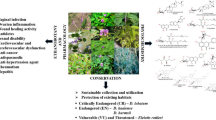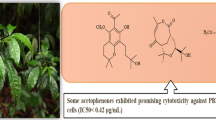Abstract
Four flavanonols (1–4), one xanthone (5), and three flavonoid glycosides (6–8), were isolated from the leaves and stems of Desmodium caudatum. Their structures were elucidated by comparing spectroscopic data with reported values. The anti-inflammatory activity of the isolated compounds was investigated in lipopolysaccharide (LPS)-stimulated bone marrow-derived dendritic cells. Among them, compounds 1 and 2 exhibited inhibitory effects on LPS-induced IL-6, IL-12 p40, and TNF-α production with IC50 values ranging from 6.0 to 29.4 μM. Compound 5 exhibited 1,1-diphenyl-2-picrylhydrazyl radical and intracellular reactive oxygen species scavenging activity in human HaCaT keratinocytes. These results warrant further studies of the potential anti-inflammatory and antioxidant benefits of compounds from D. caudatum.



Similar content being viewed by others
References
Akira, S., and K. Takeda. 1994. Toll-like receptor signalling. Nature Reviews Immunology 4: 499–511.
Aritomi, M., and T. Kawasaki. 1968. Isolation and identification of swertisin from the leaves of Desmodium caudatum A.P. de Candolie. Chemical and Pharmaceutical Bulletin 16: 1842–1843.
Bakhtiar, A., J. Gleye, C. Moulis, and I. Fourasté. 1994. O-glycosyl-C-glycosyl flavones from Galipea trifoliata. Phytochemistry 35: 1593–1594.
Beutler, B., and A. Cerami. 1986. Cachectin and tumour necrosis factor as two sides of the same biological coin. Nature 320: 584–588.
Gately, M.K., L.M. Renzetti, J. Magram, A.S. Stern, L. Adorini, U. Gubler, and D.H. Presky. 1998. The interleukin-12/interleukin-12-receptor system: role in normal and pathologic immune responses. Annual Review of Immunology 16: 495–521.
Halliwell, B. 1994. Free radicals, antioxidants, and human disease: curiosity, cause, or consequence? Lancet 334: 721–724.
Halliwell, B. 1999. Establishing the significance and optimal intake of dietary antioxidants: the biomarker concept. Nutrition Reviews 57: 104–113.
Hwang, B.Y., H.S. Kim, J.H. Lee, Y.S. Hong, J.S. Ro, K.S. Lee, and J.J. Lee. 2001. Antioxidant Benzoylated flavan-3-ol glycoside from Celastrus orbiculatus. Journal of Natural Products 64: 82–84.
Ito, C., K. Sato, T. Oka, M. Inoue, M. Juichi, M. Omura, and H. Furukawa. 1989. Two flavanones from Citrus species. Phytochemistry 28: 3562–3564.
Joseph, H., J. Gleye, C. Moulis, I. Fouraste, and E. Stanislas. 1988. O-methoxylated C-glycosylflavones from Justicia pectoralis. Journal of Natural Products 51: 804–805.
Kassim, N.K., M. Rahmani, A. Ismail, M.A. Sukari, G.C. Ee, N.M. Nasir, and K. Awang. 2013. Antioxidant activity-guided separation of coumarins and lignan from Melicope glabra (Rutaceae). Food Chemistry 139: 87–92.
Kim, M.B., J.S. Park, and S.B. Lim. 2010. Antioxidant activity and cell toxicity of pressurised liquid extracts from 20 selected plant species in Jeju, Korea. Food Chemistry 122: 546–552.
Koo, J.E., H.J. Hong, A. Dearth, K.S. Kobayashi, and Y.S. Koh. 2012. Intracellular invasion of orientia tsutsugamushi activates inflammasome in asc-dependent manner. PLoS One 7: e39042.
Ma, K.J., Z.Z. Zhu, C.H. Yu, H. Zhang, J. Liu, and L. Qin. 2011. Analgesic, anti-inflammatory, and antipyretic activities of the ethanol extract from Desmodium caudatum. Pharmaceutical Biology 49: 403–407.
Manez, S., M. Paya, C. Terencio, and A. Villar. 1988. Flavonoids of Rhamnus lycioides; part 2. Planta Medica 54: 187–188.
Nielsen, H., and P. Arends. 1979. Xanthone constituents of Hypericum androsaemum L. Journal of Natural Products 42: 303–306.
Rosenkranz, A.R., S. Schmaldienstm, K.M. Stuhlmeier, W. Chen, W. Knapp, and G.J. Zlabinger. 1992. A microplate assay for the detection of oxidative products using 2′,7′-dichlorofluorescin-diacetate. Journal of Immunological Methods 156: 39–45.
Sasaki, H., Y. Kashiwada, H. Shibata, and Y. Takaishi. 2012. Prenylated flavonoids from Desmodium caudatum and evaluation of their anti-MRSA activity. Phytochemistry 82: 136–142.
Scherer, R., and H.T. Godoy. 2009. Antioxidant activity index (AAI) by the 2,2-diphenyl-1-picrylhydrazyl method. Food Chemistry 112: 654–658.
Trinchieri, G., S. Pflanz, and R.A. Kastelein. 2003. The IL-12 family of heterodimeric cytokines: new players in the regulation of T cell responses. Immunity 19: 641–644.
Ueno, A., Y. Ikeya, S. Fukushima, T. Noro, K. Morinaga, and H. Kuwano. 1978. Studies on the constituents of Desmodium caudatum DC. Chemical & Pharmaceutical Bulletin 26: 2411–2416.
Wang, Z.H., K.A. Kang, R. Zhang, M.J. Piao, S.H. Jo, J.S. Kim, S.S. Sang, J.S. Lee, D.H. Park, and J.W. Hyun. 2010. Myricetin suppresses oxidative stress-induced cell damage via both direct and indirect antioxidant action. Environmental Toxicology and Pharmacology 29: 12–18.
Weinstein, D.L., B.L. O′Neill, and E.S. Metcalf. 1997. Salmonella typhi stimulation of human intestinal epithelial cells induces secretion of epithelial cell-derived interleukin-6. Infection and Immunity 65: 395–404.
Wu, Y., F. He, Q. Pan, Y. Shi, Z. Min, and J. Liang. 2011. C-glucosyl flavones from the seeds of Ziziphus jujuba var. Spinosa. Chemistry of Natural Compounds 47: 369–372.
Acknowledgments
This study was supported by the Priority Research Center Program (2009-0093815) and Basic Science Research Program (2010-0023645) through the National Research Foundation of Korea (NRF) funded by the Ministry of Education, Science and Technology, Republic of Korea.
Author information
Authors and Affiliations
Corresponding author
Rights and permissions
About this article
Cite this article
Li, W., Sun, Y.N., Yan, X.T. et al. Anti-inflammatory and antioxidant activities of phenolic compounds from Desmodium caudatum leaves and stems. Arch. Pharm. Res. 37, 721–727 (2014). https://doi.org/10.1007/s12272-013-0241-0
Received:
Accepted:
Published:
Issue Date:
DOI: https://doi.org/10.1007/s12272-013-0241-0




